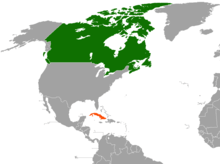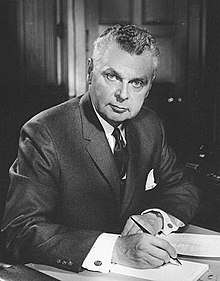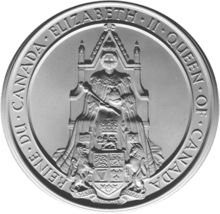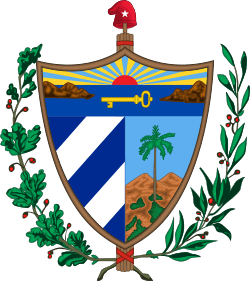Canada–Cuba relations
Canada–Cuba relations refers to the bilateral relationship between Canada and Cuba. Informal trade relations between the colonies of Atlantic Canada, and the Captaincy General of Cuba has existed since the 18th century. However, diplomatic relations between Canada and Cuba was not formally established until 1945.
 | |
Canada |
Cuba |
|---|---|
| Diplomatic mission | |
| Canadian Embassy, Havana | Cuban Embassy, Ottawa |
| Envoy | |
| Ambassador Perry Calderwood[1] | Ambassador Josefina Vidal |
Diplomatic relations between the two countries remains uninterrupted since it establishment in 1945, with Canada being one of the only two countries in the Americas to maintain relations with Cuba after the Cuban Revolution in 1959. Relations between Canada and Cuba have occasionally been a source of contention for Canada-United States relations.
Both countries maintain embassies in the other's respective capital city, in addition to consulates in other cities. Canada is Cuba's largest source for tourists, with Canadians accounting for 30 per cent of tourists who visit the country. Conversely Cuba is Canada's second largest export partner in the Caribbean/Central American region.
History
Trade relations between Canada and Cuba dates back to the 18th century, with vessels from Atlantic Canada trading cod and beer for rum and sugar in Cuba.[2] Diplomatic relations was formally established between the two countries in 1945.[2] Cuba was the first country in the Caribbean selected by Canada for a diplomatic mission.[2]
Post-Cuban Revolution

Diplomatic relations between the Canada and Cuba remained uninterrupted in the aftermath of the Cuban Revolution.[3] Canada, in addition to Mexico, remained one of only two countries in the Americas that maintained uninterrupted relations with Cuba after the revolution.[2] Although John Diefenbaker, the Prime Minister of Canada, was a staunch anti-communist, he reasoned that relations should be continued "despite the philosophical differences between [Cuba's] communist regime and the West..., and that Canada should hardly be required to tighten its trade restrictions above and beyond those of other Latin American nations."[4]
On 26 April 1959, the Prime Minister of Cuba, Fidel Castro,[note 1] visited Montreal to participate in a toy drive for Cuban children. In addition to inviting Castro, the event's organizers, the Junior Chamber of Commerce of Montreal, also invited several members of Canadian government to greet Castro, although those contacted refused to do so.[5]
The choice to maintain relations with the revolutionary Cuban government served as a point of contention for Canada-U.S. relations in the decades following the Cuban Revolution. During John F. Kennedy's tenure as the President of the United States, Diefenbaker used Canadian-Cuban relations to showcase that Canada was not mirroring the foreign policy of the United States.[4]
Cuban Missile Crisis
Canada played a minor role in the Cuban Missile Crisis, with the Royal Canadian Navy assisting the United States, and other NATO allies in searching the North Atlantic Ocean for Soviet vessels from the 24 October to the end of the crisis.[6] However, Diefenbaker's desire to maintain an independent foreign policy from the United States during the Cuban Missile Crisis, contributed towards his defeat 1963 Canadian federal election. Prior to making a public televised announcement regarding the Cuban quarantine on 22 October 1962, Kennedy had called Diefenbaker to inform him about the plan, and to request Canadian Forces be placed on DEFCON-3.[6] Diefenbaker in turn was angered that his government was not consulted earlier; and questioned Kennedy for further proof, and to first send a United Nations team to confirm it.[6] The issue led to a two-day debate in Diefenbaker's cabinet, with Minister of National Defence Douglas Harkness advocating that Canada follow the United States in raising its military readiness, given their "obligations" as members of NATO, and NORAD.[6]
Harkness's position eventually gained the support from Diefenbaker's cabinet as Soviet ships approached the American quarantine zone, and other NATO members began to voice their support for the United States.[6] DEFCON-3 was formally authorized by Diefenbaker on 24 October.[6] Diefenbaker's public perception in Canada suffered from the crisis, with the Canadian public viewing Diefenbaker as indecisive.[6] The perception as an indecisive leader, and his refusal to accept nuclear-armed CIM-10 Bomarc missiles, led to his eventual defeat to Lester B. Pearson's Liberal Party of Canada in the 1963 election.[6]
Post Cuban Missile Crisis
Although Diefenbaker was defeated in the 1963 election, his policy with Cuba was continued by the Liberal Party most notably under the tenure of Prime Minister Pierre Trudeau, who long held the opinion that Canada needed to establish a foreign policy, "independent of American influence".[3]
The Canadian government was critical of the United States embargo against Cuba during the 1960s and 1970s, objecting to American attempts to block trade to Cuba by Canadian-based American subsidiaries.[7] In 1975, the United States passed legislation, loosening the restrictions in its embargo, formally permitting foreign subsidiaries of American-based companies to conduct trade with Cuba.[7]
In 1976, Trudeau spent three days in Cuba, and sparked a personal friendship with Castro.[3][8] The visit was also the first by a Western nation to Cuba since 1960.[8] Trudeau's trip to Canada was criticized by Diefenbaker, given Cuba's involvement in the Angolan Civil War. Remarks made by Trudeau in Cuba, notably "Viva Cuba! Viva Fidel Castro," were also criticized by Diefenbaker, and Thomas Cossitt, a Canadian Member of Parliament.[3] In his memoirs, Trudeau noted that Castro downplayed Cuba's involvement in Angola during his visit, and he had only realized the extent of Cuba's involvement after returning to Ottawa. Shortly after his visit to Cuba, Trudeau cut foreign aid to Cuba.[3]
In January 1977, Canadian-Cuban relations was strained after details were made public that the Cuban government used a consular mission in Montreal for the purposes of information-gathering.[7] Five Cuban nationals were expelled from Canada, including three diplomats.[7] Canadian law enforcement was already aware of the espionage activities within the consulate, and placed the building under surveillance as early as 1972. Although Canadian authorities monitored of the Cuban consulate, they had no intention to move against consulate officials until after details of Cuban espionage were made public; which forced authorities to proceed with their expulsion.[7] In a statement of admission, the Cuban government stated it used the consulate for intelligence gathering, although noted its activities were directed against the United States government and the Central Intelligence Agency.[7]
In 1984, the Canadian government passed the Foreign Extraterritorial Measures Act, a law designed to dissuade Canadian-based American subsidiaries from taking part in the American economic embargo of Cuba.[9]
1990s–present
In 1994, a joint venture was formed between the Cuban Nickel Union and the Canadian firm Sherritt International, which operates a mining and processing plant on the island in Moa.[10] A second enterprise, Cobalt Refinery Co. Inc., was created in Alberta for nickel refining.
Canada, in addition to the European Union, objected to the passage of the Helms-Burton Act in the U.S. Congress in 1996, specifically Title III, a provision that permitted Americans whose properties were nationalized by the Cuban government, to sue individuals that are presently using it.[9] The Canadian Minister of Foreign Affairs Lloyd Axworthy stated "Canada shares the U.S. objectives of improving human rights standards and moving to more representative government in Cuba. But we are concerned that the Helms-Burton Act takes the wrong approach. That is why we have been working with other countries to uphold the principles of international law".[11][12]
In response to the Helms-Burton Act, the Foreign Extraterritorial Measures Act was amended to permit Canadians sued under the Helms-Burton Act, to counter-sue in Canadian courts. The resulting amendment also found those that paid damages under the Helms-Burton Act to be liable to fines and imprisonment in Canada.[9] In a satirical response to the Helms-Burton Act, a private member's bill known as the Godfrey-Milliken Bill was introduced in the House of Commons of Canada in response to the extraterritoriality of the Helms-Burton Act.[13][14] The proposed bill would have allowed descendants of United Empire Loyalists who fled the American Revolution to be able to reclaim land and property that was confiscated by the American government in the 1700s. Although the Helms-Burton Act went into effect in 1996, enactment of Title III was postponed until April 2019.[9][15][16]
During the mid-1990s, Canada and Cuba reached an agreement that saw the Cuban government compensate Canadians whose properties were expropriated after the Cuban Revolution.[9] Emergency economic reforms made during the Special Period in Cuba, allowed for a significant number of Canadian businesses to invest in Cuba. Increased economic activity between the two countries prompted a 41-hour official visit to Havana by Canadian Prime Minister Jean Chrétien in November 1998.[17] Chrétien faced some criticism in Canada for not publicly voicing his concerns over human rights in Cuba, although he privately discussed the issue with Castro, as well as demanded the release of four specific political dissidents.[18] However, the visit saw no critique levied at Canada from the United States government; with U.S. President Bill Clinton having urged Chrétien at the 24th G8 summit months earlier, to raise concerns about human rights to Castro during his planned visit.[18]
Castro travelled to Montreal in 2000 to serve as one of Trudeau's pallbearers at his funeral.[19]
21st century
In 2001, the Canadian government protested American preclearance customs agents in Canadian airports who tried to catch American citizens travelling to Cuba in defiance of U.S. law.[20] During the 2010 United Nations Security Council election, Cuban diplomats to the United Nations lobbied Latin American ambassadors to the United Nations General Assembly to vote for Canada.[21]
In 2013, the Canadian government hosted bilateral talks between the governments of Cuba and the United States. Seven negotiation sessions were held between the American and Cuban governments in Ottawa and Toronto.[21] The following negotiations led to the normalization of relations between the American and Cuban governments.[22] In November 2016, Canadian Prime Minister Justin Trudeau, made a 30-hour official visit to Cuba.[17]
Economic relations
Cuba is presently Canada's second largest export market in the Caribbean/Central American region, with over C$1 billion in goods traded annually.[23] There are in total 85 Canadian companies and subsidiaries operating in Cuba, including brewer Labatt Breweries.
Approximately 1.2 million Canadians visit Cuba annually.[23] With Canadian tourists account for 30 per cent of all tourists who visit Cuba per year, Canada is the largest source of tourists for Cuba.[2]
Diplomatic representation
.jpg)
Canada has had an embassy in Havana since 1945. The current building was built in 1929 and used by Canada since 1961. It also provides consular assistance to Australian and Israeli nationals.[24] The embassy is located in the upscale district of Miramar in municipal area of Playa in Havana. Canadian consulates are also found in Varadero and Holguin.[25] due to these two locations being key destinations for Canadian tourists.
Cuba has an embassy in Ottawa and consulates in Montreal, and Toronto.[26][27]
See also
Notes
- Castro governed Cuba as the Prime Minister of the country from 1959 to 1976. He governed the country as the Council of State from 1976 to 2008.
References
- "Diplomatic appointments - Perry Calderwood and Patrick Parisot". Global Affairs Canada. Government of Canada. 9 May 2019. Retrieved 28 July 2019.
- "Canada - Cuba Relations". Embassy of Canada to Cuba. Government of Canada. 1 June 2018. Retrieved 25 July 2019.
- "Viva Cuba: Trudeau goes abroad". CBC Archives. Canadian Broadcasting Corporation. 2018. Retrieved 25 July 2019.
- Molinaro, Dennis (2009). "Calculated Diplomacy': John Diefenbaker and the Origins of Canada's Cuba Policy". Our Place in the Sun: Canada and Cuba in the Castro Era. University of Toronto Press. pp. 75–95. ISBN 0-8020-9666-2.
- Neill, Brennan (28 November 2016). "How 1 man brought Fidel Castro to Montreal in April 1959". Canadian Broadcasting Corporation. Retrieved 29 July 2019.
- Stairs, Denis (9 September 2019). "Caanda and the Cuban Missile Crisis". The Canadian Encyclopedia. Historica Canada. Retrieved 10 December 2019.
- Lavnie, Michael (16 January 1977). "Spy Scandal Is Souring Canadian-Cuban Relations". The Washington Post. Nash Holdings.
- Wright, Robert (2010). Three Nights in Havana: Pierre Trudeau, Fidel Castro and the Cold War World. HarperCollins Canada. ISBN 1-5546-8931-7.
- Walkom, Thomas (18 April 2019). "How Venezuela is impacting Canada's relations with Cuba". The Toronto Star. Torstar Corporation. Retrieved 25 July 2019.
- "History of Sherritt". Sherritt International Corporation. 2012. Archived from the original on 7 May 2012. Retrieved 16 May 2012.
- "Online NewsHour: Lloyd Axworthy". Online NewsHour. Public Broadcasting Service. 23 January 1997. Retrieved 10 June 2010.
- Dmytryshyn, Ned (18 March 1996). "Ottawa Objects To Helms-Burton". The Militant. Retrieved 10 June 2010.
- "Bill C-339: The Godfrey-Milliken Bill". Archived from the original on 2013-06-18. Retrieved 10 June 2010.
- "Private Member's Bill C-339". LEGISinfo. Parliament of Canada. Retrieved 16 May 2012.
- Wilson-Smith, Anthony (29 July 1996). "Clinton's concession". Maclean's. Rogers Digital Media. Retrieved 25 July 2019.
- "Update on the Helms-Burton Act and Canadians doing business in Cuba". Embassy of Canada to Cuba. Government of Canada. 18 April 2019. Retrieved 25 July 2019.
- Robert, Wright (26 November 2016). "Castro and Trudeau: a famous, but also fraught friendship". The Globe and Mail. The Woodbridge Company. Retrieved 25 July 2019.
- "Chrétien visits Cuba". The Canadian Encyclopedia. Historica Canada. 15 December 2013. Retrieved 10 December 2019.
- "Castro mourns for Trudeau, who stood up for him". CNN.com. Cable News Network. 3 October 2000. Archived from the original on 28 September 2012. Retrieved 10 June 2010.
- McGregor, Glen; Trickey, Mike (1 September 2001). "Canada opposes U.S. crackdown on Cuba visitors". International Bicycle Fund. Retrieved 10 June 2010.
- Geddes, John (18 December 2014). "Canada's Cuban ties and the Washington-Havana thaw". Maclean's. Rogers Digital Media. Retrieved 17 August 2019.
- Clark, Campbell (17 December 2014). "Facilitiating Dialogue: Canada plays host to secret U.S., Cuban meetings". The Globe and Mail. The Woodbridge Company. Retrieved 25 July 2019.
- Kwong, Mark (18 April 2018). "Cuba's next president won't be a Castro. Here's what that means for Canada". CBC News. Canadian Broadcasting Corporation. Retrieved 25 April 2019.
- "Canada's embassy in Cuba decrepit, says audit". CTV News. BellMedia. 1 November 2009. Retrieved 2 September 2017.
- "Embassies and consulates: Cuba". Government of Canada. Retrieved 25 July 2019.
- "Consulate General of Cuba in Montreal". Embassy of Cuba in Canada. Ministry of Foreign Affairs of the Republic of Cuba. Archived from the original on 14 April 2012. Retrieved 16 May 2012.
- "Consulate General of Cuba in Toronto". Embassy of Cuba in Canada. Ministry of Foreign Affairs of the Republic of Cuba. Archived from the original on 14 April 2012. Retrieved 16 May 2012.

